Ever wondered how to transform your living room into a serene sanctuary that combines beauty with effortless simplicity? Scandinavian living room design, also known as Nordic style, has taken the world by storm with its clean lines, cozy atmospheres, and focus on natural materials. Its popularity lies in its ability to create spaces that feel both calming and functional, making it perfect for modern lifestyles that crave minimalism without sacrificing comfort.
In this article, you’ll discover a treasure trove of inspiration and practical ideas to elevate your living space with Scandinavian charm. From choosing the right color palettes and furniture to clever storage solutions and subtle decorative touches, we’ll guide you through a variety of design tips that emphasize simplicity and elegance. Whether you’re starting fresh or looking to refresh your current setup, these ideas will help you craft a beautifully balanced, inviting living room that perfectly embodies Nordic style.
1. Embrace Neutral Color Palettes for a Calm and Cohesive Look
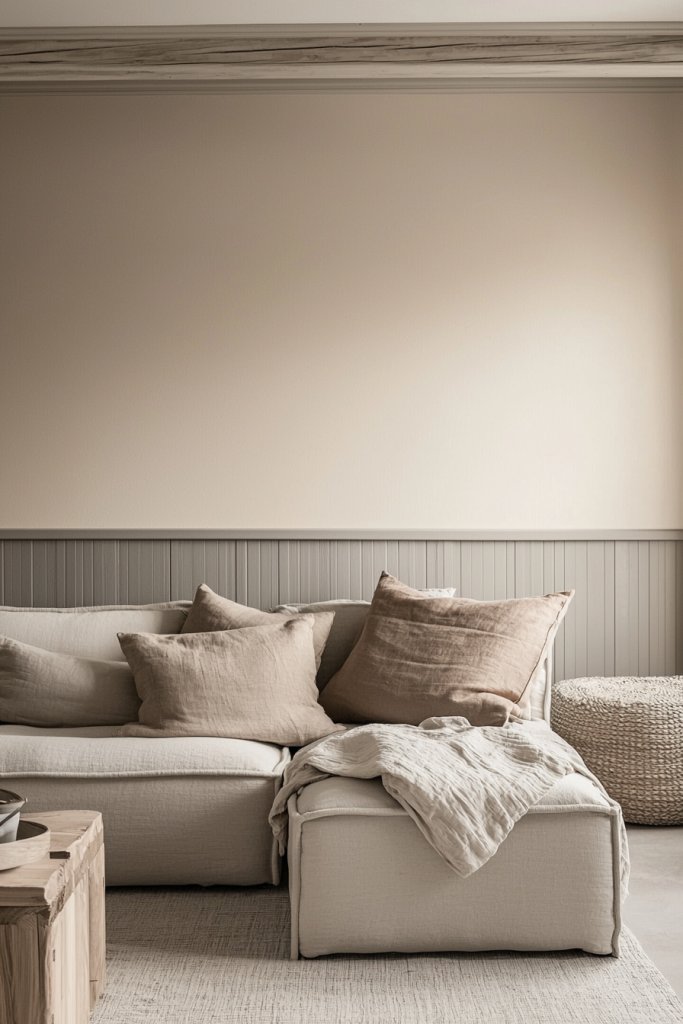
Creating a serene and harmonious living room starts with choosing the right color palette, and neutral shades are at the heart of Scandinavian design. Think soft beiges, warm creams, cool grays, and gentle taupes that set a calming tone without overwhelming the senses.
These hues serve as a perfect backdrop, making the space feel open, airy, and inviting. When paired with natural materials, they enhance the minimalist aesthetic while promoting a sense of tranquility.
Imagine walking into a living room where walls are painted in a crisp, matte white, complemented by plush sofas in muted beige or light gray. The floor is a light oak or ash wood, adding warmth without adding color.
Accents like a soft cream throw blanket with chunky knit texture or a set of cushions in subtle hues subtly break the monochrome, adding tactile interest. The overall effect is a cohesive space that feels peaceful, uncluttered, and effortlessly stylish—an ideal retreat from everyday chaos.
To implement this, start by selecting a neutral base for your walls—white, soft gray, or warm taupe—and keep large furniture in similar muted tones. Incorporate textiles like throw blankets and cushions in shades that complement each other, avoiding overly bright or busy patterns.
Use natural wood finishes for furniture and flooring to deepen the warmth. This approach is budget-friendly and beginner-friendly, as it relies on simple color coordination and natural materials, creating a timeless foundation for your Nordic-inspired living room.
2. Incorporate Minimalist Furniture with Clean Lines and Functional Design
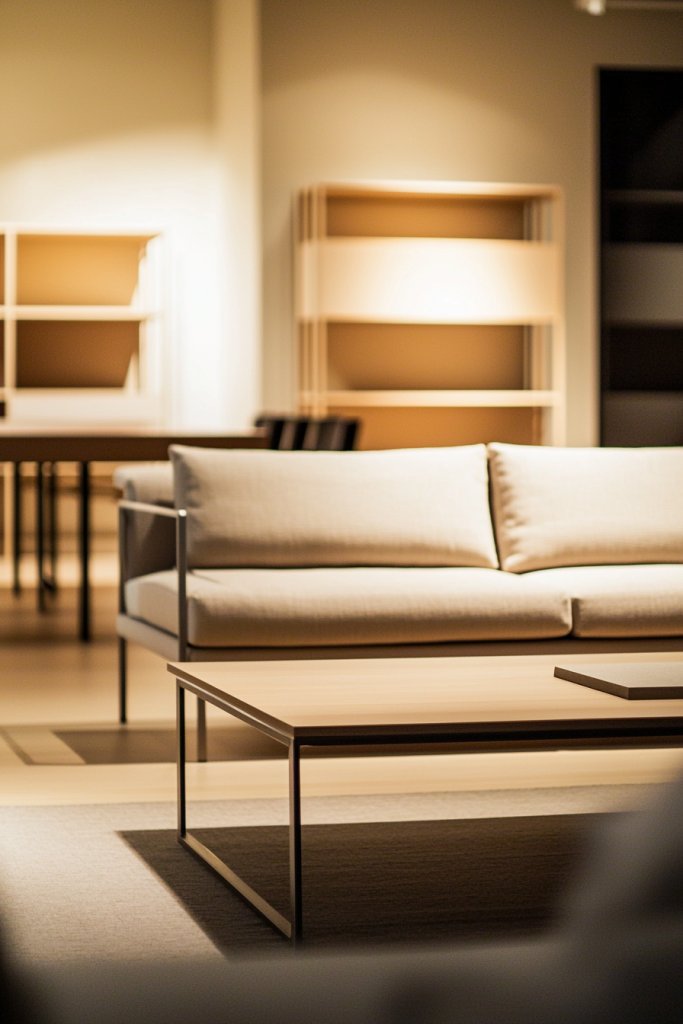
The essence of Scandinavian style is functional beauty—furniture that is sleek, simple, and highly practical. Think pieces with straight, unadorned lines, smooth surfaces, and minimal ornamentation that emphasize form and function equally.
This approach not only keeps the space feeling uncluttered but also ensures each piece serves a purpose, promoting a clutter-free and serene environment. Picture a low-profile sofa in light gray linen fabric, with slim metal or wooden legs that lift it just above the floor.
A rectangular coffee table made of natural light wood with rounded edges adds warmth and visual softness. Modular shelving units with open, geometric designs allow you to display essentials neatly while maintaining an airy feel.
These pieces should blend seamlessly into the space, highlighting functionality without sacrificing style, and encouraging a sense of calm. To bring this look into your home, opt for furniture with simple silhouettes—avoiding overly ornate or bulky items.
Focus on natural materials like wood, metal, and linen, which are durable and eco-friendly. Consider multi-purpose pieces, such as a storage ottoman or a sofa with built-in compartments, to maximize space.
Beginners can look for ready-made minimalist furniture or consider DIY options like assembling flat-pack pieces. The key is to prioritize simplicity, comfort, and practicality, creating a cohesive, clutter-free living room.
3. Use Light Wood Flooring to Enhance Natural Brightness and Warmth
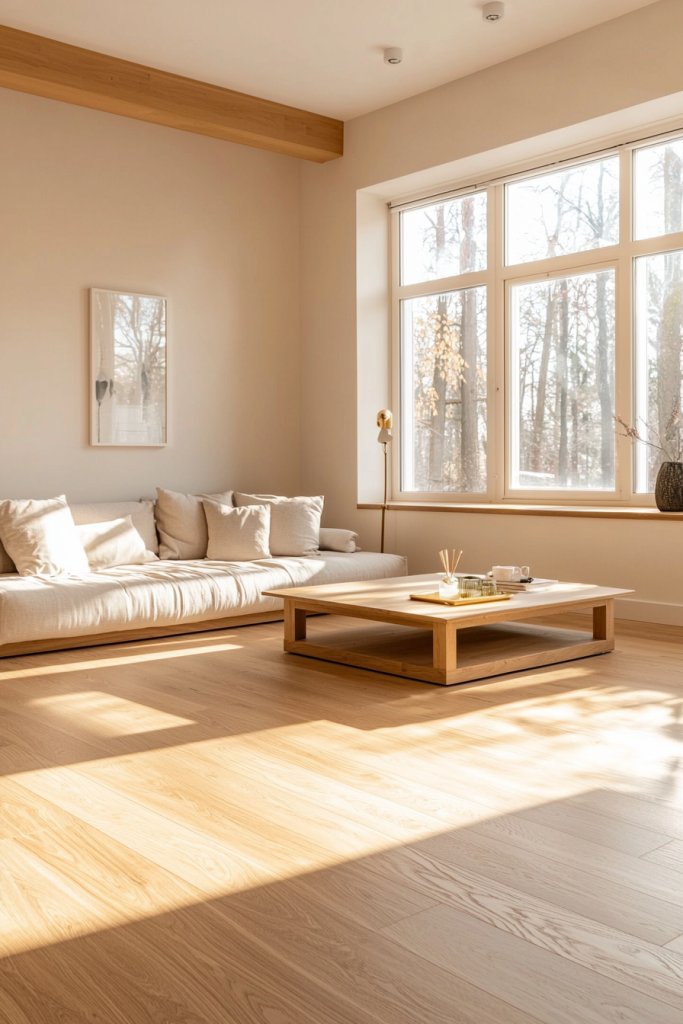
Light wood flooring is a cornerstone of Scandinavian living rooms, instantly adding a sense of openness, brightness, and warmth. Its natural hue reflects sunlight, making even small spaces feel larger and more inviting.
Moreover, the subtle grain patterns and matte finishes of light oak, ash, or maple create a tactile richness that complements neutral palettes and minimalist furniture. Visualize stepping into a living room with wide-plank light oak flooring, its soft, pale tone anchoring the entire space.
The flooring’s natural texture invites barefoot strolls and enhances the cozy feel of the room. Paired with white or light-colored walls and furniture, it amplifies the sense of airiness and serenity.
The overall environment exudes calmness and freshness, perfect for relaxing or entertaining guests in a stylish yet understated setting. To achieve this look, start with high-quality laminate or engineered wood flooring in a light finish, which is often more affordable and easier to install.
Consider options with matte or satin surfaces to prevent glare and enhance the natural look. Ensure proper underlayment for comfort and insulation.
For DIY installation, follow manufacturer instructions carefully, and pair the floor with light-colored area rugs if desired for added texture. This flooring choice is a simple yet impactful way to elevate your Scandinavian living space with warmth and brightness.
4. Add Textured Rugs in Soft, Muted Tones to Create Comfort and Depth
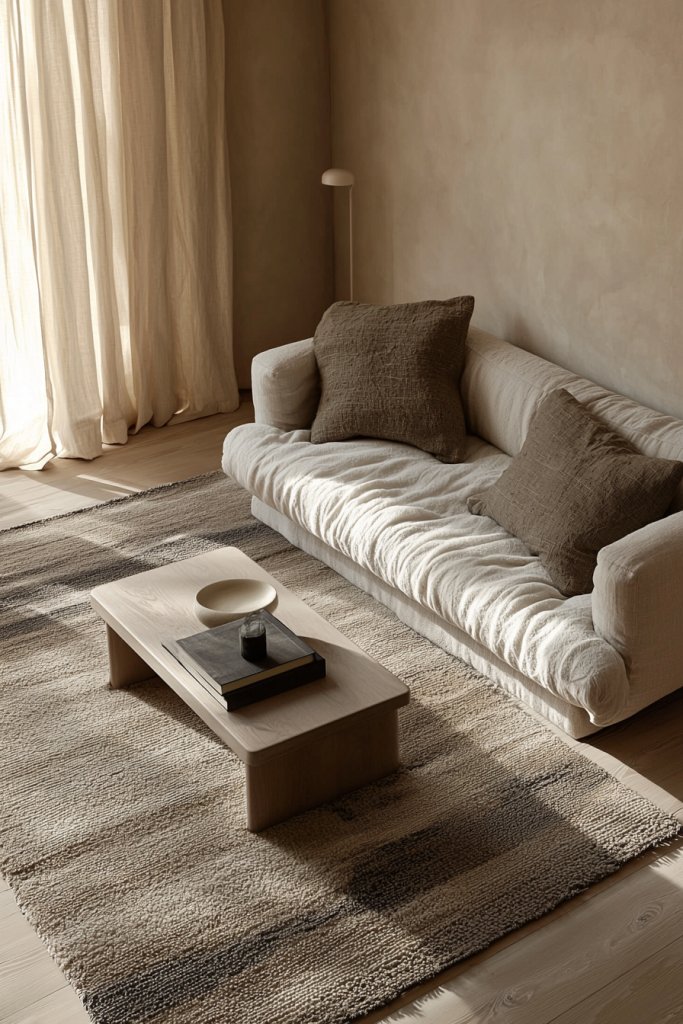
A textured rug is the perfect finishing touch to add warmth, softness, and visual interest to a Scandinavian living room. Opt for rugs in muted, earthy tones—beige, taupe, or gentle grays—that complement the neutral palette.
The tactile quality of chunky knits, woven wool, or plush shag creates a welcoming atmosphere, inviting you to kick off your shoes and relax. Imagine a large, soft rug with a chunky knit pattern in warm cream or light gray, layered under a minimalist coffee table and sofa.
Its textured surface not only adds depth to the space but also absorbs sound, making the room feel cozy and calm. When you walk on it, you’ll notice a comforting tactile sensation that enhances the sensory experience of your living environment.
The muted tones ensure it blends seamlessly with other decor elements, elevating the overall aesthetic. To incorporate this idea, choose a rug made from natural fibers like wool or jute for durability and eco-friendliness.
Pick a size that fits your seating area—large enough to anchor your furniture without overwhelming the space. Layer smaller textured rugs for added dimension if desired.
For DIY options, consider knitting or sourcing handmade rugs on platforms like Etsy. This simple addition significantly enhances the comfort and visual appeal of your Nordic-inspired living room.
5. Incorporate Cozy Throw Blankets and Cushions in Simple Patterns
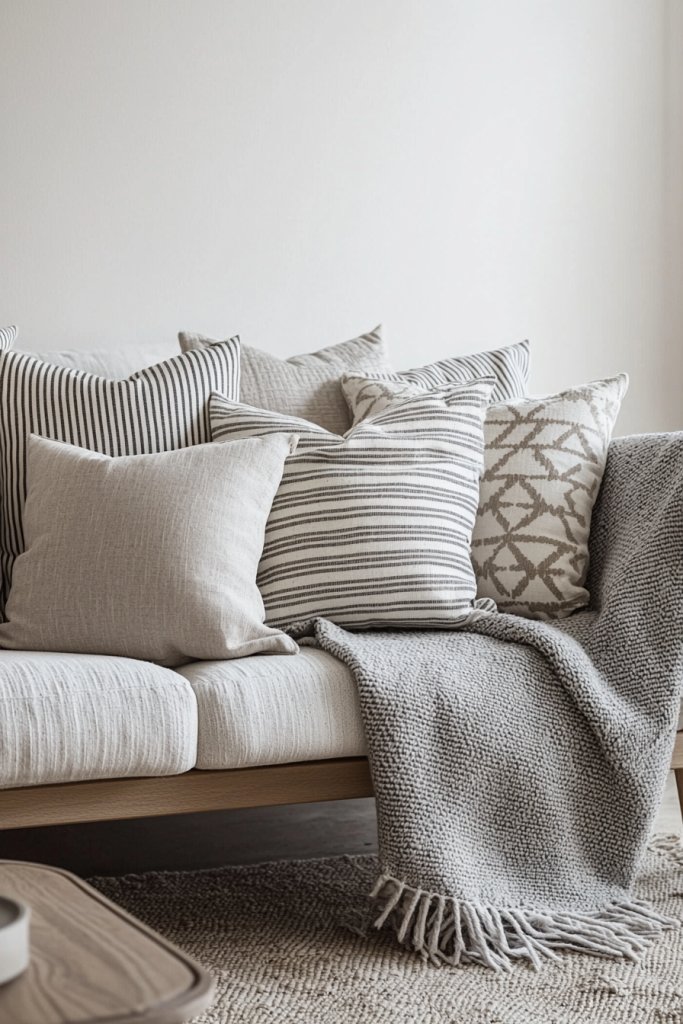
Textiles like throw blankets and cushions are essential for adding warmth, comfort, and subtle visual interest to a Scandinavian living room. Stick to simple, understated patterns—think stripes, geometric shapes, or solid colors in muted tones—that complement the overall neutral palette.
Their tactile textures and soft fabrics invite you to curl up and unwind, making the space feel more inviting and lived-in. Visualize a cozy corner with a soft cream throw blanket draped over a light gray sofa, paired with cushions in muted beige and pale blush with subtle geometric embroidery.
The combination of textures—knit, linen, and velvet—adds depth without cluttering the aesthetic. These accents create a layered look that feels effortless yet thoughtfully curated, enhancing the room’s serenity and warmth.
They also serve as versatile accessories that can be easily swapped out to refresh the space. To achieve this, opt for durable, machine-washable fabrics like linen, cotton, or wool in neutral shades.
Choose cushions with simple covers—you can sew your own or find affordable options online—and select throws in cozy knits or plush materials. Layering these textiles in different sizes and textures is a quick way to add visual interest and comfort. The result is a welcoming living area that encourages relaxation while maintaining a clean, minimalist look.
6. Opt for Open Shelving to Showcase Stylish Storage Solutions
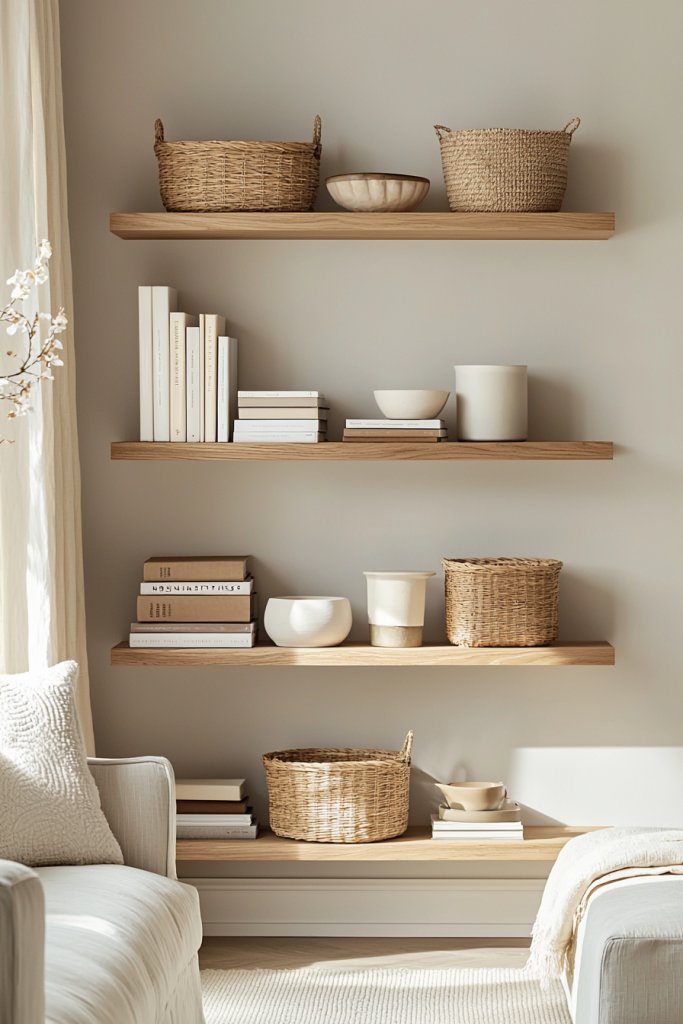
Embracing open shelving in your Scandinavian living room not only boosts functionality but also elevates the aesthetic with a clean, airy feel. It’s a smart way to display your favorite decor pieces while keeping clutter at bay, perfectly aligning with the minimalist Nordic ethos of simplicity and practicality.
Picture sleek, white or light wood shelves mounted against a soft, neutral wall. These shelves hold a curated collection of ceramic vases in muted earth tones, neatly stacked books with minimalist covers, and small sculptures crafted from natural materials like stone or wood.
The open design invites natural light to flow freely, creating a sense of spaciousness, and the arrangement offers a visual balance that feels calm yet inspiring. The overall look is uncluttered, with everything having its place, making the space feel inviting and thoughtfully curated.
To bring this idea to life, start by choosing light wood or painted white floating shelves that suit your space. Install them at different heights for visual interest, ensuring they are securely anchored into the wall studs.
Use simple brackets or go for a seamless, hidden mounting system for a sleek appearance. Style the shelves with a mix of practical storage and decorative objects—think ceramic bowls, woven baskets, or glass jars—and keep the arrangement balanced and uncluttered. Remember, less is more, so select a few meaningful pieces rather than overcrowding your shelves for the ultimate Scandinavian look.
7. Utilize Multi-Functional Furniture to Maximize Space and Practicality
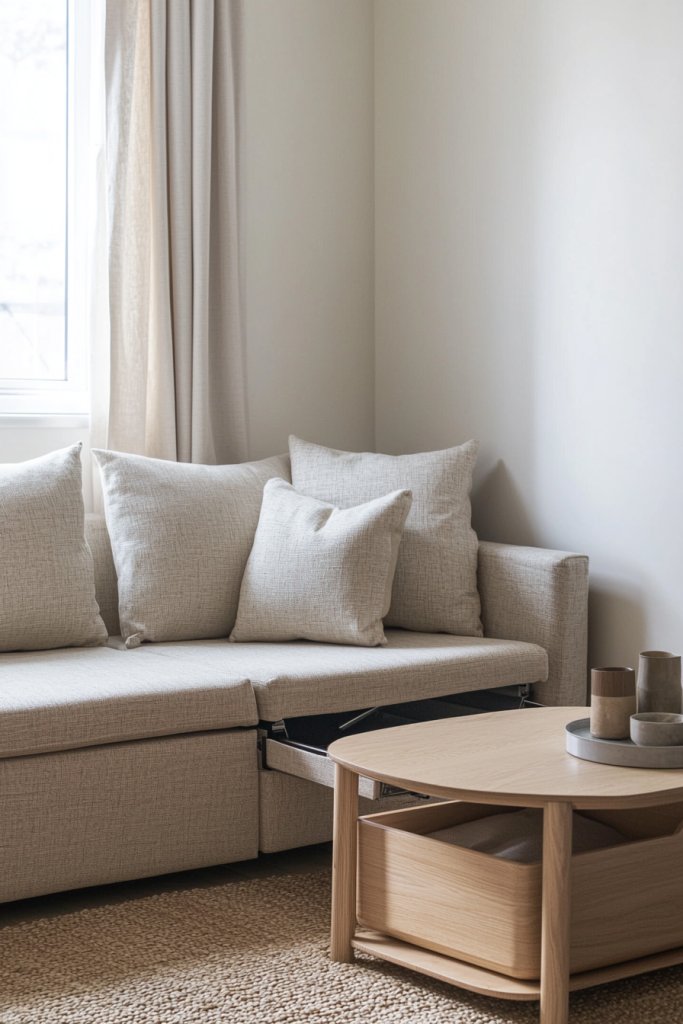
In a Scandinavian living room, multi-functional furniture is essential for optimizing space without sacrificing style. These versatile pieces combine practicality with sleek, minimalist design, making them ideal for smaller or open-plan spaces where every square inch counts.
Imagine a low-profile storage ottoman upholstered in a soft, neutral fabric, which doubles as a coffee table and extra seating. Or a sofa bed with clean lines, featuring hidden compartments for blankets and pillows, perfect for hosting guests.
A fold-out dining table that tucks neatly against the wall when not in use can double your space for relaxation and dining. These pieces are typically crafted from light woods or matte-finished metals, maintaining the airy, uncluttered feel characteristic of Nordic interiors.
The focus is on simple forms with hidden storage that keeps the room tidy and functional. To implement this, look for furniture pieces labeled as multi-purpose or modular, such as a bench with built-in storage or a sofa with hidden compartments.
Choose neutral tones and natural materials like birch or oak to blend seamlessly into your Nordic aesthetic. When shopping, prioritize items with clean lines and minimal ornamentation, making sure they fit your space both practically and visually. Assembly is usually straightforward—just follow the manufacturer’s instructions—and accessorize with plush, neutral cushions or throws to add comfort and warmth while maintaining a sleek silhouette.
8. Install Sleek, Modern Lighting Fixtures with Geometric Shapes
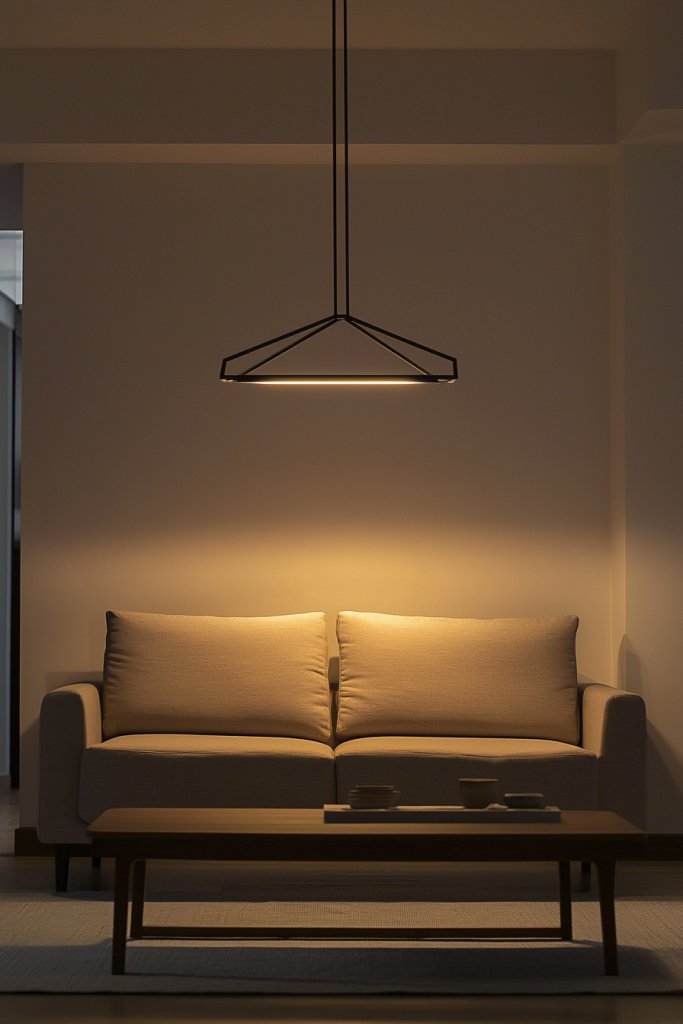
In Scandinavian design, lighting isn’t just functional—it’s a statement of style that adds ambiance and visual interest. Modern fixtures with geometric shapes elevate the room’s clean aesthetic while providing warm, inviting light that enhances the space’s calm, minimalist vibe.
Picture a pendant light in the shape of a simple black or matte white sphere, or a sculptural metal chandelier with angular, geometric arms. Floor lamps with slender, straight lines and a minimalist shade in neutral tones can cast soft, diffused light across the room.
These fixtures often feature materials like matte metal, frosted glass, or natural wood accents, blending seamlessly with the overall aesthetic. When illuminated, they create focused pools of warm light that highlight textures like soft textiles or smooth ceramics, adding depth and coziness.
To install these fixtures, start by selecting a geometric pendant or chandelier that complements your ceiling height and room size. Use existing electrical boxes for easy mounting or hire an electrician for more complex fixtures.
Opt for warm LED bulbs to create a cozy atmosphere. For floor lamps, position them near seating areas for reading or ambiance, ensuring the design remains unobtrusive yet eye-catching. Keep the overall look sleek and simple—avoid overly ornate details—to stay true to the Nordic style’s understated elegance.
9. Choose Scandinavian-Inspired Coffee Tables with Natural Wood Finish
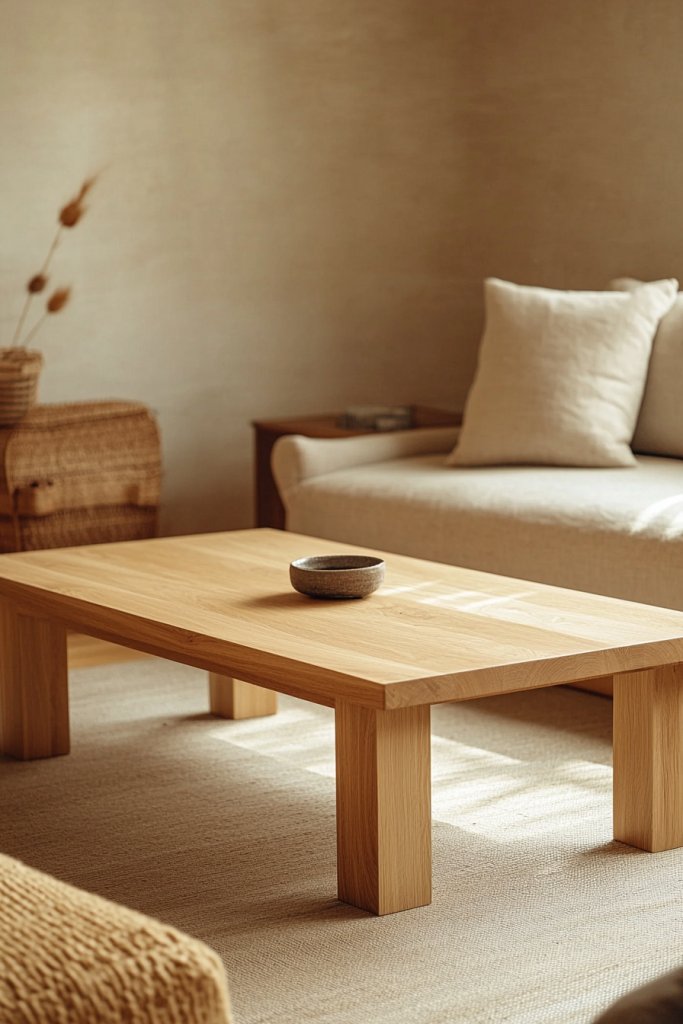
A Scandinavian-inspired coffee table acts as a functional centerpiece that embodies the natural, minimalist aesthetic of Nordic design. Its simple form, combined with natural wood tones, brings warmth and harmony to the living room.
Visualize a low, rectangular table crafted from light oak or birch, with smooth, rounded edges that invite touch. Its surface is often left unadorned to showcase the natural grain of the wood, adding subtle texture to the space.
The table’s legs are slender and unobtrusive, creating an open, airy feel that complements other furniture pieces. You might place a few carefully curated objects—like a ceramic tray, a small plant in a neutral pot, or a stack of books—on top to enhance its visual appeal without cluttering.
The overall effect is a balanced, serene focal point that anchors the room with understated elegance. Start by choosing a simple, sturdy wooden coffee table in a light finish.
You can find many designs at furniture stores or opt for DIY kits if you enjoy woodworking. Keep the look clean by avoiding overly ornate details or bright colors—stick to natural, matte finishes.
Pair your table with neutral-toned cushions or throws to soften the space further. This piece is versatile enough to fit into various room sizes and layouts, providing both style and practicality with minimal effort.
10. Use White or Light-Colored Walls to Amplify Natural Light
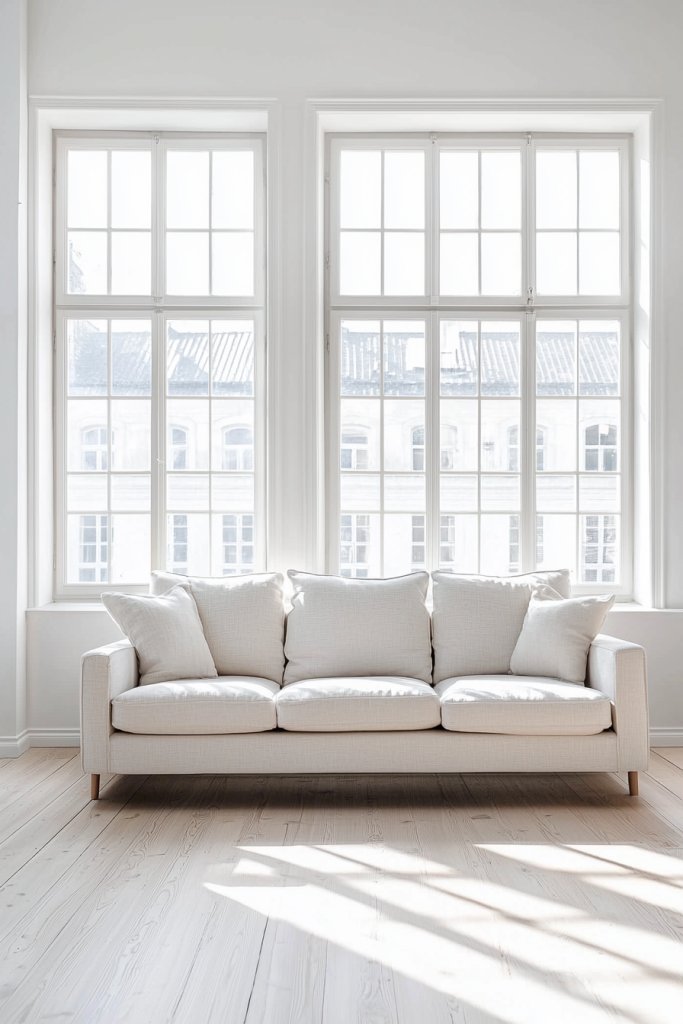
Bright, airy walls are a hallmark of Scandinavian living rooms, serving as a perfect backdrop to emphasize natural light and highlight the simplicity of Nordic design. Light-colored walls make spaces feel larger, more open, and inviting.
Imagine a living room with walls painted in a crisp, matte white or a very soft beige, reflecting sunlight that streams through large windows. The walls act as a neutral canvas, allowing other design elements—like light wood furniture, textured textiles, and subtle decor—to stand out beautifully.
These tones also create a calming atmosphere, making the space feel fresh and uncluttered. When paired with minimalist window treatments—such as sheer linen curtains—this approach maximizes daylight while maintaining privacy.
The overall effect is a luminous, spacious environment that embodies the Scandinavian principle of “less is more.” To achieve this, start by choosing high-quality matte paint in white, ivory, or subtle pastel shades. If painting isn’t an option, consider using light-colored wallpaper with subtle textures or patterns.
Keep window dressings light and airy—think linen or sheer fabrics—to let natural light flood the room. Complement the walls with light-colored furniture and textiles to enhance the sense of openness. Regularly clean your windows and keep clutter minimal to maintain the bright, fresh ambiance that characterizes Nordic interiors.
11. Decorate with Subtle Metallic Accents in Matte Finish for a Touch of Elegance
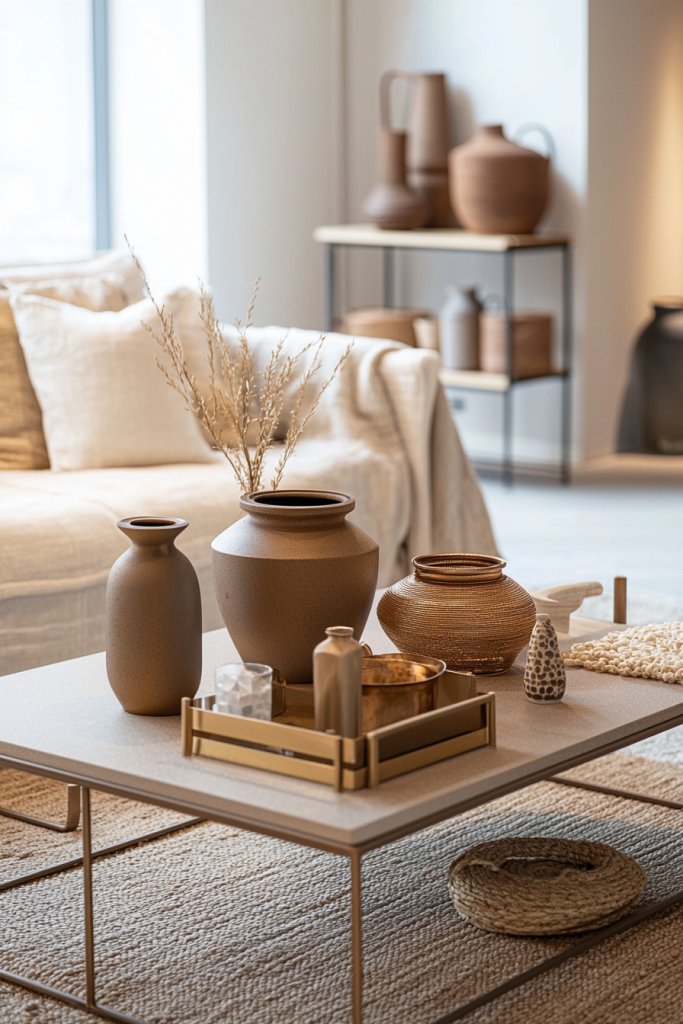
Adding subtle metallic accents in matte finishes is a fantastic way to elevate the understated elegance of Scandinavian interiors without overpowering their minimalist aesthetic. These accents bring a refined shimmer that catches the eye softly, creating a sophisticated yet cozy atmosphere.
Think of small details like matte gold or brushed brass picture frames, candle holders, or decorative bowls that add just a hint of luxury while maintaining the calm, neutral palette. Picture a living room where a matte brass side table complements a neutral-toned sofa, or a set of muted gold candle holders on a light wood shelf.
The textures are smooth but not glossy, offering a muted metallic glow that reflects ambient light beautifully. These accents work well against the backdrop of soft, neutral walls and natural materials, subtly drawing attention to well-curated details.
The overall effect is one of understated elegance that feels both modern and timeless. To incorporate these accents, start with a few small, matte metallic objects—like a tray, a vase, or picture frames—and place them thoughtfully on open shelves or side tables.
Choose finishes like matte gold, blackened brass, or muted silver to keep the look cohesive. Keep the overall metallic presence restrained to avoid clutter or distraction; the goal is a harmonious blend of textures that elevates the space without overwhelming it.
12. Incorporate Built-In Storage Solutions to Maintain Clutter-Free Spaces
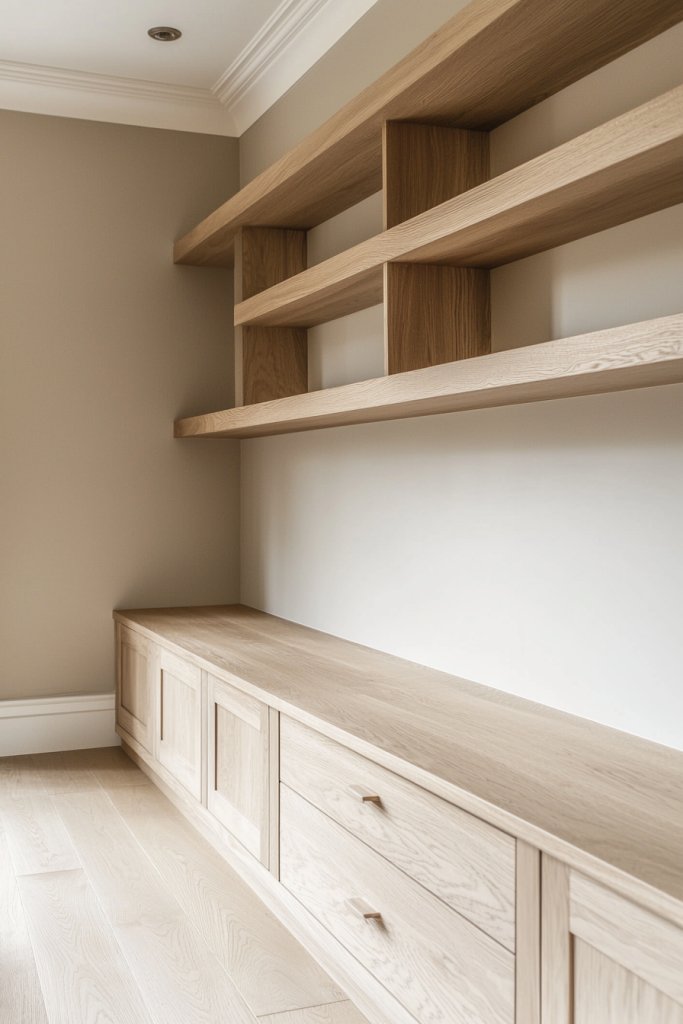
Built-in storage is a hallmark of Scandinavian design, emphasizing clean lines and seamless organization that keeps the living space looking tidy and serene. This approach involves integrating storage units directly into walls or furniture, creating a streamlined look that minimizes visual clutter and maximizes functionality.
It’s perfect for small spaces where every inch counts, helping to maintain the calm aesthetic that defines Nordic style. Imagine a wall with custom-built, recessed shelves that blend into the wall itself, painted in a light, neutral tone to match the surrounding walls.
These shelves can hold books, ceramics, or decorative objects, keeping them accessible yet unobtrusive. Alternatively, a built-in media unit with hidden compartments can hide electronic devices and accessories, maintaining sleek surfaces.
The key is to choose simple, minimalist designs with smooth finishes and subtle profiles that don’t detract from the overall calm. To implement, assess your space and determine where built-in storage can be most effective—above a fireplace, behind a wall, or beneath a window seat.
Use materials like light-colored wood or painted MDF to match your walls or flooring. If DIY isn’t an option, consult a carpenter or use modular systems that mimic built-ins, ensuring they blend seamlessly into your room’s aesthetic. Keep accessories inside these storage units organized with baskets or boxes for a tidy, clutter-free look.
13. Select Simple, Elegant Window Treatments in Light Fabrics
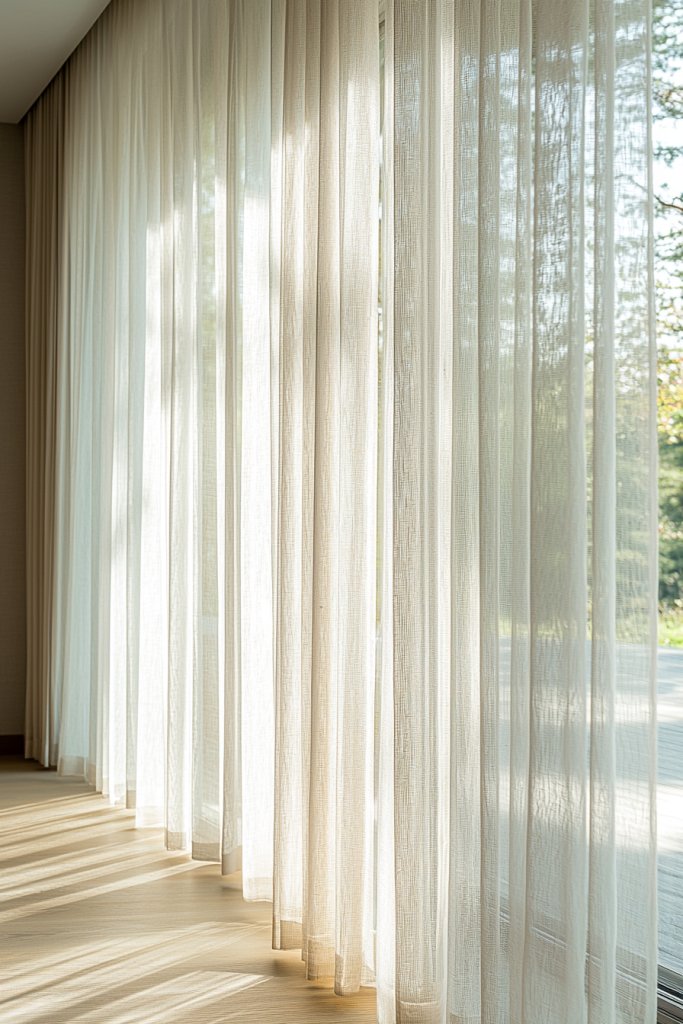
In Scandinavian living rooms, window treatments are chosen with an eye toward simplicity, natural light, and texture. Light, airy fabrics like linen, cotton, or sheer voile allow sunlight to gently filter through, creating a warm and inviting ambiance.
These treatments add softness to the space without competing with other design elements, maintaining the minimalist, clean-lined aesthetic characteristic of Nordic style. Visualize sheer white curtains flowing softly in the breeze, gently diffusing daylight across a room painted in warm neutrals.
The fabrics feel light and breathable, adding a tactile layer that invites touch. When pulled back, they reveal the view outside, making the space feel open and connected to nature.
Their understated elegance complements the natural wood tones and muted color palette, enhancing the overall sense of calm and simplicity. To achieve this look, choose curtains in lightweight fabrics like linen or cotton in neutral shades—white, beige, or soft gray.
Opt for simple rod placements, either wall-mounted or ceiling-mounted, with no ornate finials. For a more minimal feel, consider roller blinds or shades in sheer fabrics, which can be layered with heavier drapes if needed. Installation is straightforward, and these treatments can be easily maintained with regular washing or gentle cleaning, making them both practical and stylish.
14. Highlight Architectural Details with Subtle Molding or Paneling
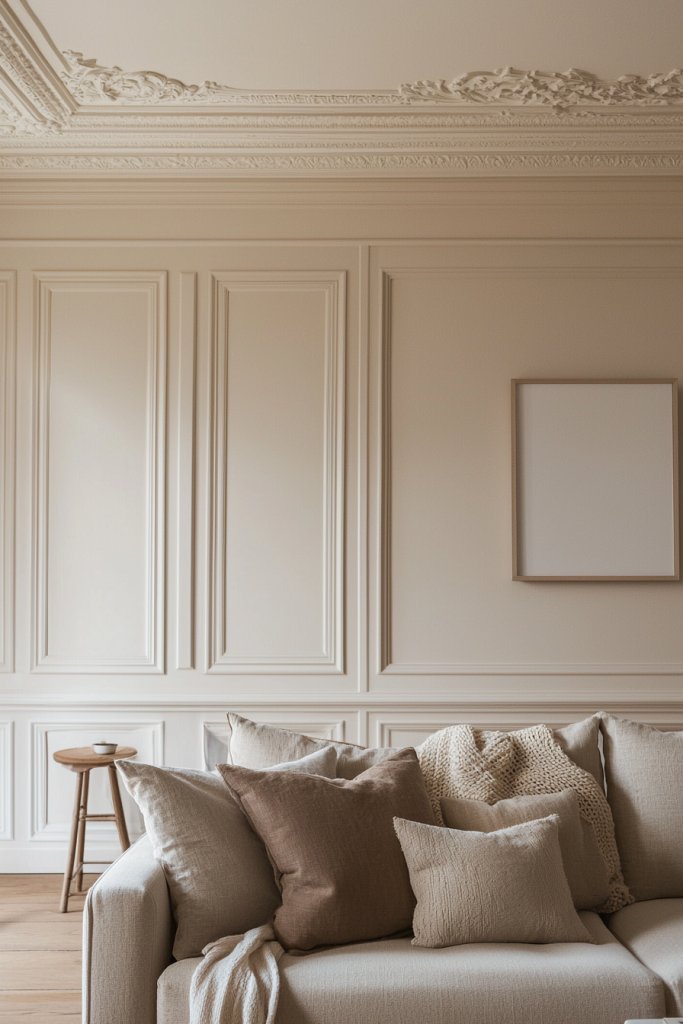
Incorporating subtle molding or wall paneling brings a quiet layer of architectural interest to Scandinavian living rooms, enhancing their sense of craftsmanship and detail without cluttering the space. These features define the walls and ceilings with clean, geometric lines, adding depth and texture that complement the minimalist aesthetic.
They draw the eye and lend a timeless sophistication that elevates the overall design. Picture a wall with delicate crown molding or simple wainscoting painted in a crisp white or soft neutral tone.
Alternatively, vertical or horizontal wooden paneling in light oak or ash can add warmth and visual interest. These details create a refined backdrop for furniture and decor, subtly emphasizing the room’s proportions and craftsmanship.
The overall effect is elegant yet understated, enhancing the room’s natural light and airy feel. To incorporate, choose slim, unobtrusive molding or paneling that aligns with your room’s proportions.
For DIY projects, purchase pre-cut molding or panel kits and follow straightforward installation guides, ensuring precision with a level and proper adhesives. Keep the color palette neutral—white, light gray, or natural wood—to maintain cohesion with the Scandinavian style. These details can be added to one feature wall or throughout the entire room, instantly elevating the space’s architectural character with minimal effort.
15. Use Monochrome or Limited Color Accents in Decor Items
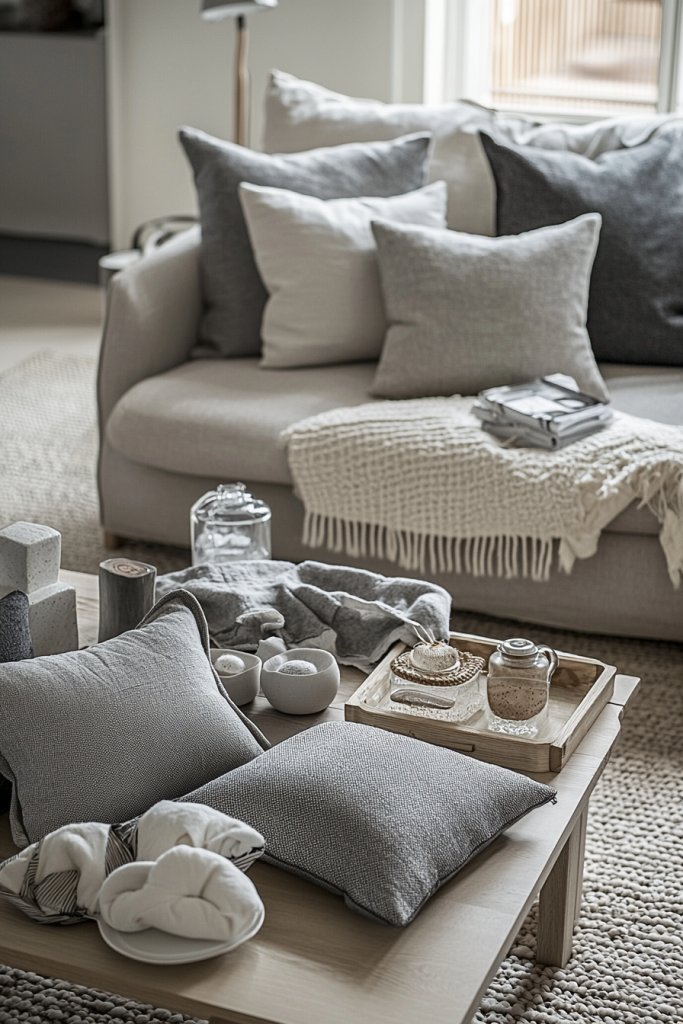
Sticking to monochrome or limited color schemes in decor items is a core principle of Scandinavian design, creating harmony and visual calm. Using shades within a narrow palette—such as various tones of gray, beige, or muted pastels—allows each piece to complement the others organically.
This restrained approach ensures that the decor enhances the room’s serenity rather than distracting from it, fostering a peaceful environment. Imagine a living room decorated with cushions, throws, and vases in shades of soft gray, warm beige, or dusty pink.
Each item subtly varies in tone and texture, adding depth without introducing chaos. Small accents like candle holders or decorative bowls in similar hues reinforce cohesion.
The result is a curated, minimalist space where everything feels balanced, soothing, and effortlessly stylish. To achieve this, select a signature color or neutral palette and source decor items—cushions, ceramics, or textiles—in complementary shades.
Limit your choices to a handful of tones to prevent visual clutter. Mix textures—smooth ceramics, plush textiles, matte finishes—to add interest without breaking the monochrome harmony. This approach keeps the room feeling unified, calm, and welcoming, embodying the essence of Nordic simplicity.
16. Add Sculptural Ceramics and Vases in Neutral or Earth Tones
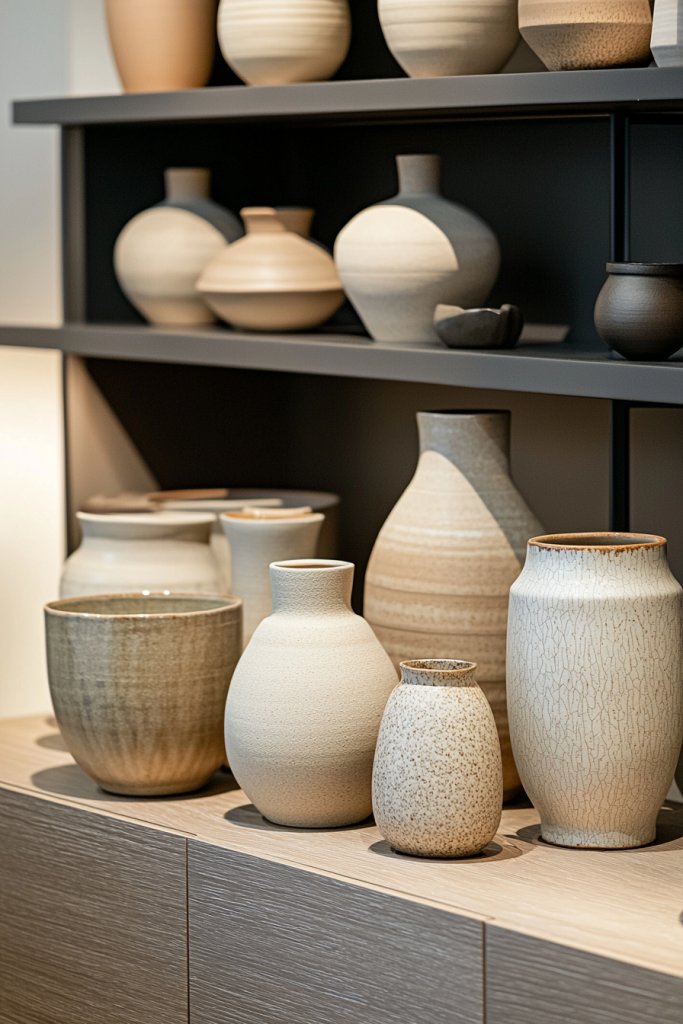
In a Scandinavian living room, carefully chosen ceramics and vases serve as the perfect finishing touch to an understated yet sophisticated aesthetic. These sculptural pieces add an element of artistry and personality, elevating the space without overwhelming its minimal charm.
Their presence subtly enhances the overall harmony, making the room feel curated and thoughtfully designed. Picture a collection of smooth, matte ceramic vases in shades of warm beige, soft gray, and muted taupe arranged on a sleek, low sideboard or a floating shelf.
Some vessels feature organic, asymmetrical shapes with textured surfaces, inviting tactile engagement. These objects reflect natural forms, balancing simplicity with artistic flair.
Their understated elegance complements neutral walls painted in crisp white or soft greige, while the tactile quality adds warmth and depth to the room’s visual palette. The ceramics evoke a sense of calm and serenity, blending seamlessly into the Nordic aesthetic.
To incorporate these pieces, start by sourcing sculptural ceramics from local artisans, home decor stores, or online platforms like Etsy. Choose vases and sculptures in neutral or earth tones—think sandy beige, charcoal gray, or stone-like textures—so they harmonize with your existing color scheme.
Place a few on a side table, shelf, or mantel, mixing different heights and shapes for visual interest. Keep the arrangement simple and uncluttered to maintain the minimalist, elegant vibe that defines Scandinavian style.
17. Incorporate Textured Wall Panels or Wooden Slats for Visual Interest
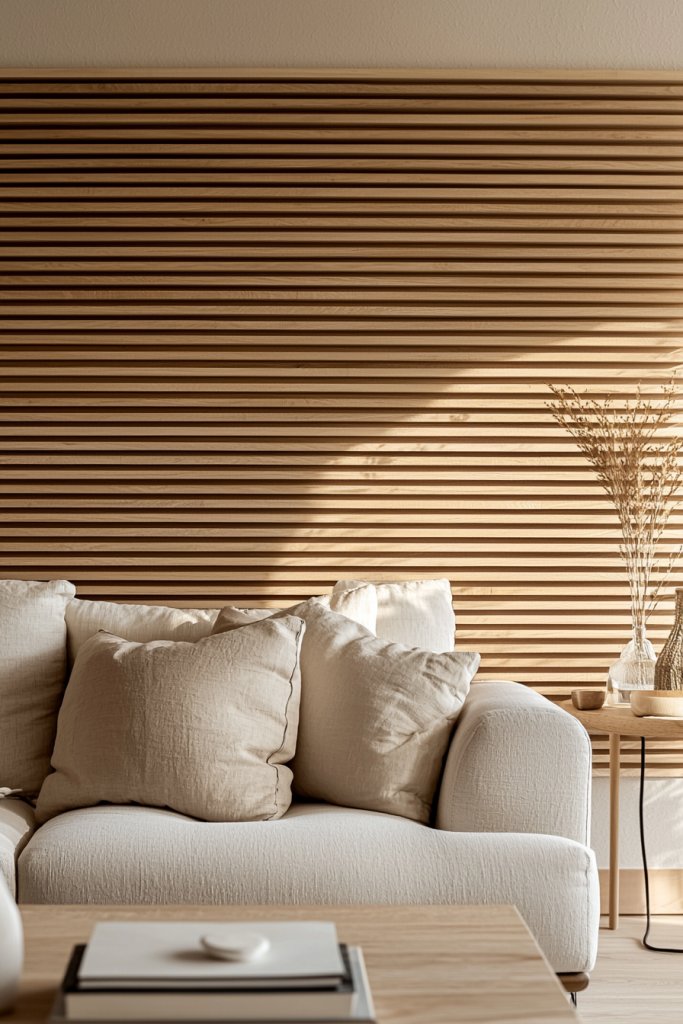
Adding textured wall panels or wooden slats introduces a subtle yet impactful layer of visual interest to a Scandinavian living room. These design elements break up plain surfaces and create a tactile backdrop that enhances the room’s natural, organic feel.
They provide depth and dimension without cluttering the space, perfectly aligning with the Nordic commitment to understated beauty. Imagine a feature wall adorned with horizontally aligned light oak or birch wooden slats, spaced evenly to create a rhythmic pattern.
Alternatively, textured wall panels in soft, woven materials or geometric wooden designs can add a cozy, layered effect. These elements catch the light differently throughout the day, casting gentle shadows that animate the space.
The natural wood tones and textures evoke the warmth of Scandinavian interiors, making the room feel inviting and tranquil. The overall look remains minimalist but rich in visual detail.
To implement this idea, consider purchasing pre-made wooden slats or textured panels from home improvement or decor stores. For DIY options, attach light-colored wooden planks or woven wall coverings using adhesive strips or nails, ensuring they are evenly spaced.
If you prefer a more subtle touch, install a narrow strip of wooden slats along the wall behind a sofa or media unit. Keep the color palette neutral—light oak, ash, or birch—to maintain the airy, clean aesthetic typical of Nordic interiors.
18. Choose Scandinavian-Style Modular Sofas with Low Profiles

A Scandinavian-style modular sofa with a low profile is the cornerstone of a functional, stylish living room that epitomizes Nordic simplicity. These sofas are designed for versatility, comfort, and clean lines, making them ideal for creating a cozy yet uncluttered environment.
Their minimalist silhouette reinforces the room’s spacious, airy feel. Visualize a sleek, low-slung sectional upholstered in soft, neutral fabric—think light gray, beige, or blush—complemented by slim, unobtrusive legs in matte black or light wood.
The modular design allows for flexible arrangements, whether you want a cozy corner or an open seating plan. The cushions are plush but structured, inviting relaxation without visual bulk.
The low back and streamlined form keep the space feeling open and uncluttered. Pairing it with simple textiles and natural accessories completes the harmonious Nordic look.
To bring this piece into your home, look for modular sofas from brands like IKEA’s EKTORP or similar Scandinavian-inspired collections. Opt for neutral, durable fabrics that are easy to clean and add a few soft throw pillows in muted tones or subtle patterns for added comfort.
If budget is a concern, consider using a sleek futon or a minimalist daybed as an alternative. Position the sofa centrally, leaving enough space around it for movement, and keep surrounding decor minimal to let the sofa be the statement piece.
19. Use Layered Lighting with Floor Lamps and Table Lamps for Ambiance
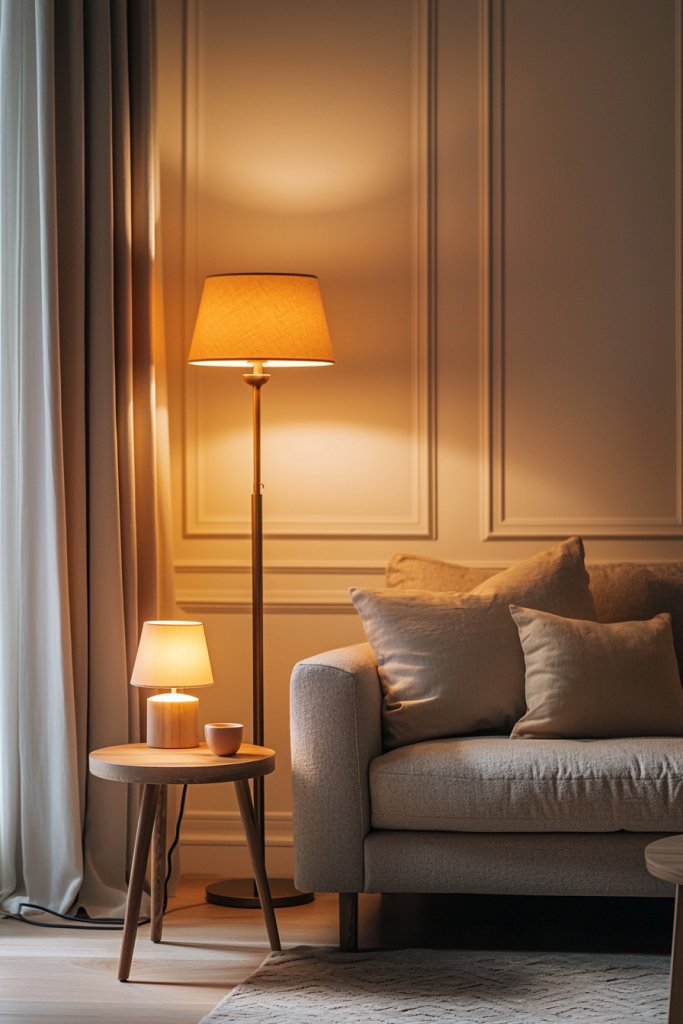
Creating the perfect Scandinavian living room atmosphere involves more than just overhead lighting—layered lighting with floor and table lamps invites warmth, intimacy, and flexibility. This approach allows you to adjust the mood according to the time of day or activity, emphasizing the cozy, inviting nature of Nordic interiors.
Picture a tall, slender black or matte brass floor lamp with a simple, geometric shade standing beside a sofa, casting a warm, diffused glow. Complement this with a few table lamps featuring neutral-colored ceramic or matte metal bases topped with soft linen or cotton shades.
These lamps can be placed on side tables or shelves, creating pools of soft light that gently illuminate the room. The combination of layered lighting adds depth and warmth, making the space feel welcoming and lived-in.
The soft glow highlights natural textures and materials, enhancing the overall Scandinavian aesthetic. To implement this layered lighting scheme, start with a statement floor lamp that complements your furniture’s clean lines.
Add a couple of table lamps on side tables or shelves, choosing designs with simple, understated shapes. Use warm white bulbs (around 2700K) to produce a cozy ambiance.
If you prefer, incorporate dimmer switches for adjustable brightness, and consider using candles or LED fairy lights for additional softness. This layered approach not only elevates the style but also makes your living space adaptable and comfortable at all hours.
20. Incorporate Practical Storage Ottomans and Side Tables
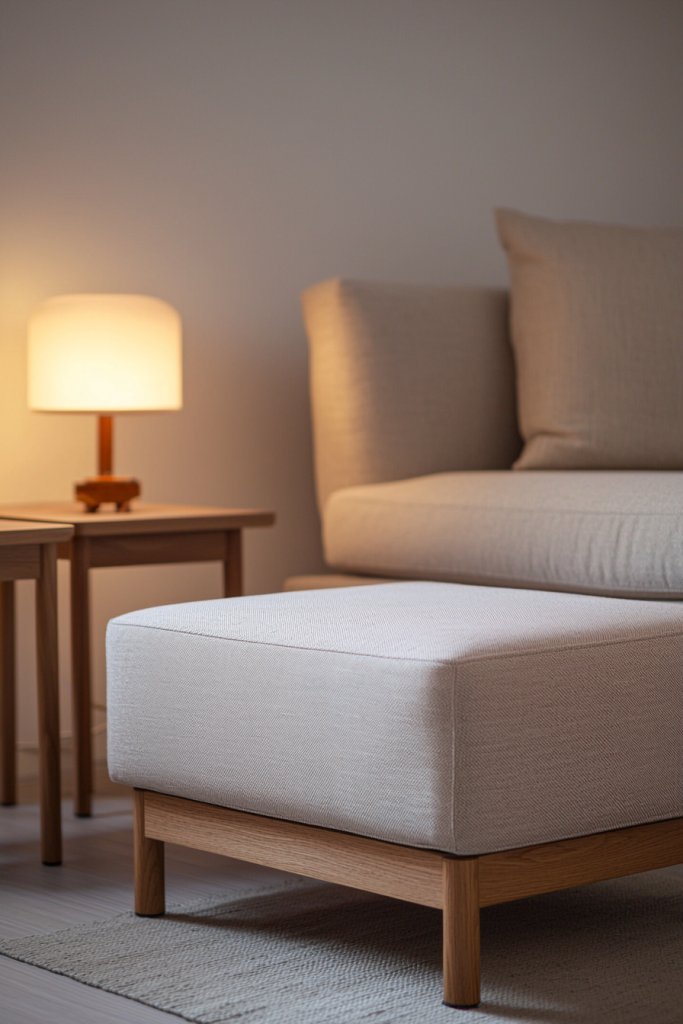
Practicality meets sleek design with storage ottomans and side tables, which are essential for maintaining the clutter-free, minimalist charm of a Scandinavian living room. These versatile pieces serve dual purposes: functional storage and stylish accents, seamlessly blending form and function.
Imagine a soft, neutral-colored fabric or leather storage ottoman with a lid that lifts to reveal space for blankets, magazines, or toys. It’s placed at the foot of the sofa, inviting relaxation and organization.
Nearby, a simple light wood side table with clean lines and a smooth surface provides space for a lamp, books, or decorative objects like ceramic bowls or textured vases. These pieces are understated but thoughtfully designed, often featuring hidden compartments or baskets for extra storage.
Their neutral tones and natural materials enhance the calm, uncluttered atmosphere characteristic of Nordic interiors. To incorporate these elements, choose a storage ottoman made from durable, easy-to-clean materials like linen or faux leather, in shades like soft gray, beige, or blush.
For side tables, select minimalist designs with natural wood finishes or matte metals—alternatively, repurpose vintage crates or baskets as storage solutions for a more eclectic look. Position the ottoman and side tables strategically around your seating area, making sure they’re accessible yet unobtrusive. This combination keeps your living room tidy, functional, and beautifully aligned with Scandinavian principles of simplicity and practicality.
21. Add Decorative Baskets in Natural Fibers for Storage and Style
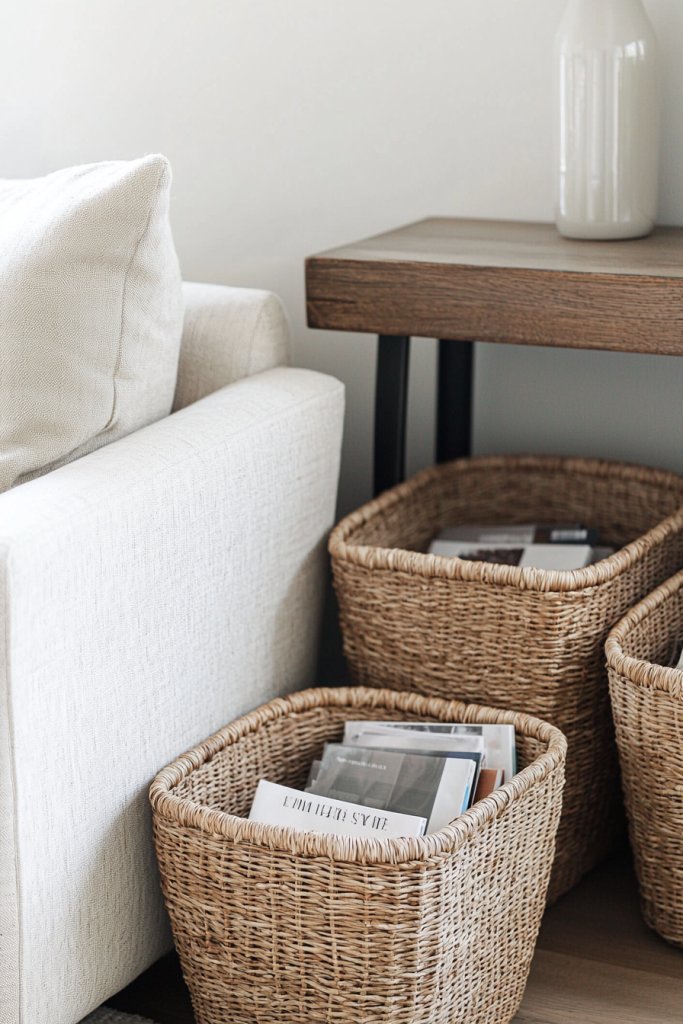
Decorative baskets crafted from natural fibers are a simple yet impactful way to add texture and warmth to a Scandinavian living room. They serve as stylish storage solutions that blend seamlessly with the overall minimalist aesthetic.
Picture woven baskets in shades of beige, soft taupe, or light gray, with intricate yet understated patterns, sitting neatly beside sofas or under coffee tables. These baskets are often made from rattan, seagrass, or jute, which bring a tactile, earthy quality that invites touch and adds visual interest.
Their organic shapes and neutral tones create a cozy, inviting atmosphere that emphasizes natural materials and craftsmanship. Visually, these baskets introduce layered textures into the space—rough woven surfaces contrast beautifully with smooth wooden furniture or soft textiles.
They can be used to store plush throws, magazines, or small household items, keeping clutter out of sight while maintaining a curated look. The natural fibers also reflect light softly, adding subtle warmth and depth to the room.
When filled, they subtly emphasize the Scandinavian value of functional beauty, making the space feel both effortless and organized. Their versatility allows them to be placed in various spots, from open shelves to corners, enhancing the room’s organic, harmonious vibe.
To incorporate these baskets, start by choosing sizes and shapes that fit your space—round, oval, or rectangular. Look for woven options in natural fibers like seagrass or rattan, which are widely available at home goods stores or online.
For a budget-friendly alternative, repurpose old baskets or use DIY weaving kits. Place them near seating areas or under tables to store essentials like throws and magazines. Regularly clean or shake them out to maintain their appearance, and enjoy the added warmth and texture they bring to your Nordic-inspired living room.
22. Style with Simple, Geometric Wall Mirrors to Enhance Space

A sleek, geometric wall mirror can instantly elevate the sense of space and light in a Scandinavian living room. These mirrors often feature clean lines and minimalist shapes—think hexagons, circles, or elongated rectangles—that complement the understated elegance of Nordic design.
They reflect natural daylight, bouncing it around the room and making even small spaces feel more open and airy. The frames are usually in matte metals like black, brass, or steel, adding a subtle touch of sophistication without overwhelming the room’s calm aesthetic.
Visually, these mirrors act as focal points that draw the eye and help define the room’s layout. Their geometric forms add visual interest and modernity, contrasting beautifully with soft textiles and wooden furniture.
When placed strategically—above a console table, near a cozy reading nook, or flanking a fireplace—they create a balanced, harmonious composition. The reflective surface also enhances the room’s textures, such as a chunky knit throw or woven baskets, by highlighting details and adding depth.
Overall, these mirrors serve as both functional and decorative elements that amplify the brightness and simplicity of the space. To incorporate a geometric wall mirror, select a size appropriate for your wall and a shape that complements your room’s layout.
Look for options with matte or brushed metal frames for a contemporary feel. Hang the mirror at eye level or slightly above to maximize light reflection and visual balance.
For easy installation, use sturdy hooks and secure anchors if needed. Pair it with other minimal decor elements, like a sleek console or a small shelf, to complete the look. This simple addition instantly makes your living room feel more spacious, bright, and thoughtfully curated.
23. Introduce Subtle Patterns Through Textiles like Throws and Cushions
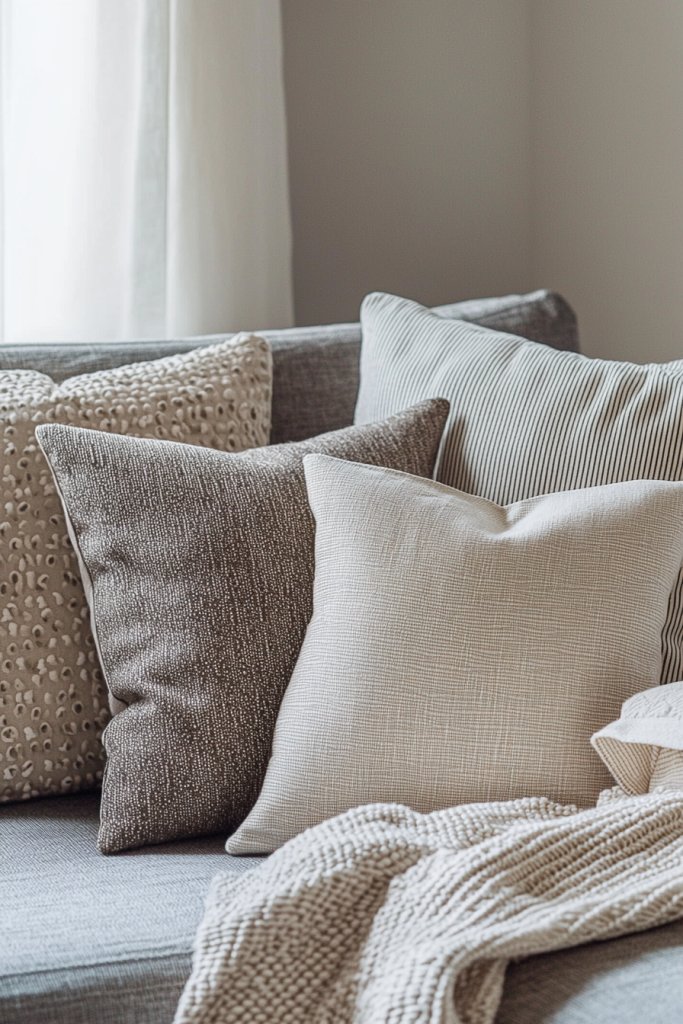
Soft textiles with subtle patterns are essential for adding depth and personality to a Scandinavian living room without disrupting its minimalist ethos. Think of cushions in muted tones like blush, soft gray, or warm beige, with delicate geometric or linear designs that provide visual interest without overwhelming the senses.
Throws in cozy fabrics like chunky knit, linen, or brushed cotton can feature understated patterns—stripes, small chevrons, or subtle textural weaves—that invite touch and create a layered, inviting look. Visually, these textiles introduce gentle movement and variation through their patterns and textures.
Cushions with simple designs break up solid-colored sofas, while textured throws add tactile richness, making the space feel warm and lived-in. The muted color palette ensures the patterns don’t compete but instead enhance the overall calmness of the room.
The combination of soft textiles creates a cozy cocoon that feels both stylish and comfortable, perfect for lazy weekends or quiet evenings. These details help ground the room in Scandinavian principles of simplicity and subtlety, elevating the space from plain to visually engaging.
To achieve this look, select cushions and throws in neutral, earthy tones with small, unobtrusive patterns. Mix textures—like a smooth linen cushion paired with a chunky knitted throw—to add depth.
For easy updates, choose removable covers in fabrics like cotton or linen, which are simple to wash and swap out seasonally. Place cushions on a low-profile sofa or armchair, and drape throws over the back or armrests. Focus on maintaining a cohesive color scheme to keep the aesthetic serene and balanced, while allowing the subtle patterns and textures to bring warmth and visual interest to your living room.
24. Focus on Symmetry and Balance in Furniture Arrangement
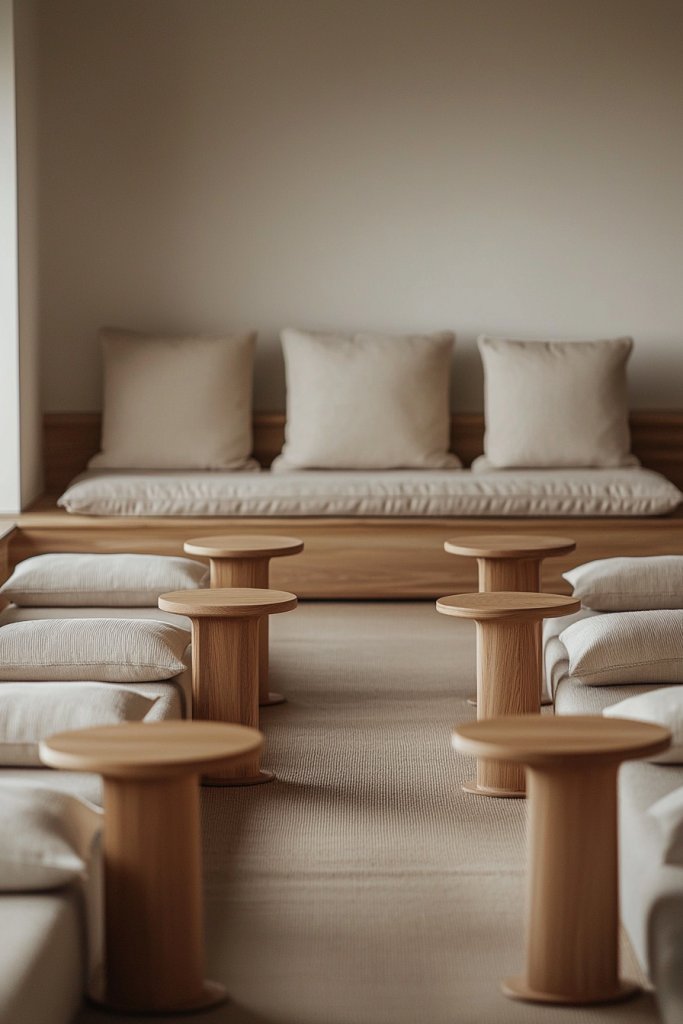
Creating a sense of harmony in a Scandinavian living room is all about symmetry and balance, which foster a calming, organized environment. Start by arranging furniture so that key pieces—like sofas, armchairs, and side tables—are positioned to mirror each other across a central axis.
For instance, place two identical armchairs facing a shared coffee table, with a sofa centered behind or opposite them. This arrangement encourages a conversational flow and visually stabilizes the space, making it feel thoughtfully curated rather than cluttered.
Visually, symmetry guides the eye smoothly across the room, emphasizing clean lines and minimalist aesthetics. It also highlights the room’s proportions, making even a small space feel well-proportioned and inviting.
Balance is achieved through the thoughtful placement of decorative objects—such as matching lamps, vases, or cushions—on either side of a central point. This careful arrangement helps prevent visual chaos and instead promotes serenity, which is fundamental to Nordic design.
When balanced properly, the space feels harmonious, welcoming, and effortlessly stylish. To implement this, start by sketching out your furniture layout or using a digital room planner.
Position larger pieces symmetrically, ensuring similar spacing and alignment. Use matching or complementary decor items on each side to reinforce symmetry.
Keep pathways clear and avoid overcrowding, focusing on a clean, uncluttered look. Adjust furniture placement until you achieve a natural sense of equilibrium, and then add final touches like cushions or small accessories to enhance the visual harmony. This approach transforms your living room into a peaceful, balanced sanctuary.
25. Finish with Minimalist Decorative Accessories that Highlight Natural Materials
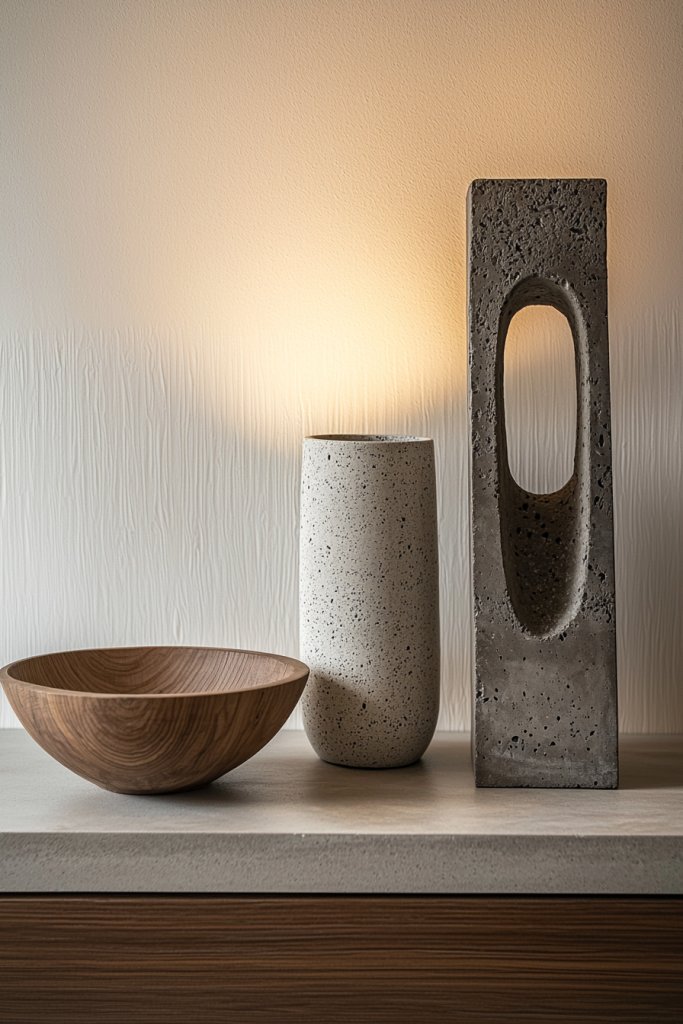
The finishing touch in a Scandinavian living room is often found in carefully selected minimalist accessories that highlight natural materials. Think of simple ceramic bowls, wooden sculptures, or stoneware vases in muted earth tones—these pieces add subtle visual interest without overpowering the space.
Small, thoughtfully curated objects placed on shelves, side tables, or mantels serve as accents that echo the room’s natural, understated aesthetic, creating a cohesive and elegant look. Visually, these accessories emphasize texture and materiality—smooth ceramics, rough-hewn wood, matte stone—that deepen the room’s organic feel.
Their minimalist design ensures they don’t clutter the space but instead serve as quiet focal points, enhancing the overall calm and simplicity. Arranged in asymmetrical groupings or aligned symmetrically, these elements draw attention to craftsmanship and natural beauty, reinforcing the Scandinavian principles of functional elegance and understated refinement.
When used sparingly, these accessories elevate the room’s style and create a welcoming, harmonious atmosphere. To incorporate these touches, choose a few high-quality pieces in neutral or earth tones—like a matte ceramic vase or a carved wooden tray.
Place them thoughtfully on a sideboard, coffee table, or shelf, balancing size and visual weight. Mix different textures to add subtle contrast and interest.
Keep clutter to a minimum, allowing each piece to stand out and contribute to the overall aesthetic. With just a few well-chosen accessories, your living room will exude effortless sophistication rooted in natural materials.
Conclusion
By embracing neutral palettes, minimalist furniture, natural textures, and thoughtful lighting, you can effortlessly create a serene and stylish Scandinavian living room that exudes simplicity and elegance. These ideas offer a versatile blueprint for elevating your space while maintaining comfort and functionality. Don’t hesitate to incorporate these Nordic-inspired touches—transform your home into a haven of calm and timeless beauty today!
Leave a Reply